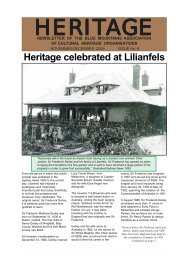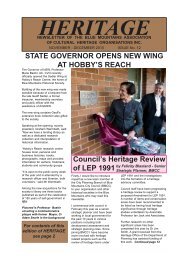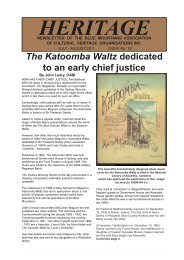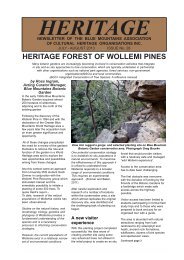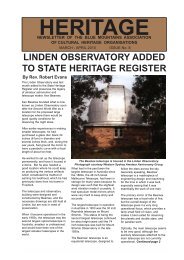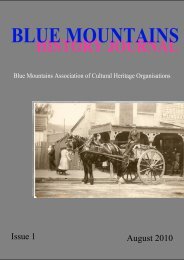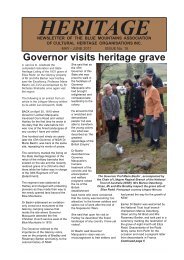Newsletter No - Blue Mountains Association of Cultural Heritage ...
Newsletter No - Blue Mountains Association of Cultural Heritage ...
Newsletter No - Blue Mountains Association of Cultural Heritage ...
Create successful ePaper yourself
Turn your PDF publications into a flip-book with our unique Google optimized e-Paper software.
Continued from page 5<br />
To the Europeans the <strong>Mountains</strong><br />
were for a long time an infernal<br />
nuisance full <strong>of</strong> ‘impassable<br />
chasms’ , with the plateau an arid<br />
and unattractive area to hurry<br />
across to get to the other side.<br />
It was only gradually in the<br />
nineteenth century that the<br />
mystique <strong>of</strong> the Sublime gathered<br />
force and, as Kate Hartig felicitously<br />
observed: ‘the aesthetic appraisal<br />
<strong>of</strong> the mountain landscape was<br />
cloaked in a romantic image and<br />
was expressed by sentiments <strong>of</strong><br />
exaltation and delight.’<br />
The grand concept <strong>of</strong> the Sublime<br />
in the nineteenth century fostered<br />
an appreciation <strong>of</strong> the savagely<br />
scenic.<br />
In Europe, the Alps ceased to be a<br />
confounded nuisance for travellers<br />
to surmount and became instead<br />
somewhere to walk, to climb, to<br />
sketch, to admire. It is one aspect<br />
<strong>of</strong> the invention <strong>of</strong> the holiday.<br />
Once it was known in the 1810s that<br />
there was another side to the <strong>Blue</strong><br />
<strong>Mountains</strong>, leading to promising<br />
plains for European animals to<br />
graze and erode, the stretch from<br />
Glenbrook to Mount Victoria was<br />
seen primarily as a hazardous<br />
intermission between the good<br />
grazing on the Cumberland Plain<br />
and the next accessible patch in<br />
Hartley Vale.<br />
And in that intermission there was<br />
precious little for animals or people<br />
to eat or drink. This perception took<br />
half a century to moderate. The<br />
<strong>Mountains</strong> road was still ‘dreary and<br />
desolate’ to Louisa Meredith in<br />
1839.<br />
What happened in the <strong>Blue</strong><br />
<strong>Mountains</strong>, as elsewhere in the<br />
course <strong>of</strong> the nineteenth century, is<br />
a very European realisation that,<br />
while a road may very well have<br />
been constructed to lead from A to<br />
B and that one ventured on that<br />
road at A with the sole wish to reach<br />
B as safely and expeditiously as<br />
possible, nonetheless there may be<br />
pleasures to be found along the way<br />
<strong>of</strong> which one had not dreamt.<br />
It is not quite the world where ‘It is<br />
better to travel hopefully than to<br />
arrive’, but it is a world where new<br />
possibilities and new realisations<br />
were gradually opened up.<br />
The gardens at <strong>No</strong>oroo, Mt Wilson - the summerhouse framed by<br />
wisteria, maples and rhododendrons<br />
So mountain retreats sprang up,<br />
<strong>of</strong>ten in spectacular situations, like<br />
Yester Grange at Wentworth Falls<br />
or Eurama at Faulconbridge, cool<br />
places for the well-to-do to escape<br />
the discomfort <strong>of</strong> summer weather<br />
in Sydney or Newcastle.<br />
Two became recognisable hill<br />
stations in the pattern <strong>of</strong> the Indian<br />
raj: these were Mount Wilson and<br />
Kurrajong Heights.<br />
And country retreats and hill<br />
stations called for gardens, like<br />
those which Silas Clifford-Smith will<br />
be talking about this morning. And<br />
this is true not only <strong>of</strong> the hillstations;<br />
it is equally true <strong>of</strong> the later<br />
gardens, symbolised in the<br />
twentieth century by the work <strong>of</strong><br />
Paul Sorensen, that ambivalent<br />
icon.<br />
Many <strong>of</strong> these gardens, and their<br />
successors, are now on display<br />
every year as part <strong>of</strong> such things as<br />
the Leura Festival. They are no<br />
less manicured and have created<br />
no less ruthless clearings <strong>of</strong> the<br />
environment within throwing<br />
distance <strong>of</strong> the World <strong>Heritage</strong> park.<br />
That does not mean that I do not<br />
admire them nor that I do not<br />
recommend many <strong>of</strong> them for<br />
heritage listing, <strong>of</strong>ten at a state-wide<br />
level <strong>of</strong> significance.<br />
But there is a tight-rope to walk<br />
when weighing up just what has<br />
been the impact <strong>of</strong> some <strong>of</strong> these<br />
gardens on the heritage values <strong>of</strong><br />
the <strong>Mountains</strong>.<br />
...the irony <strong>of</strong><br />
classic gardens<br />
which we love<br />
so much at Mt<br />
Wilson...<br />
It always strike me as an irony that<br />
the classic gardens which we all<br />
love so much at Mount Wilson are<br />
in fact exotic importations created<br />
by the deliberate destruction <strong>of</strong> the<br />
rich natural vegetation <strong>of</strong> the basalt<br />
cap, with its rain-forest and tree-fern<br />
under-storey.<br />
The character <strong>of</strong> Mount Wilson is<br />
complex, just as its Indian<br />
counterpart, Simla, is complex, for<br />
reasons both similar and dissimilar.<br />
Neither has a simple,<br />
uncomplicated relationship between<br />
the original environment and the<br />
modified.<br />
And because each has a seasonal<br />
occupation by the wealthy<br />
pr<strong>of</strong>essional folk who need to<br />
escape hot and humid cities, each<br />
has also a different sort <strong>of</strong><br />
permanent resident, those who take<br />
care <strong>of</strong> the estates and form their<br />
own very different community<br />
throughout the year.<br />
HERITAGE 6<br />
<strong>No</strong>vember - December 2012




